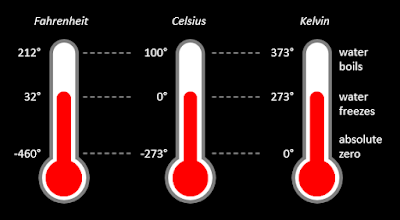Ha!
I made my own version.
In three scenarios, you're dead.
(Scientifically, correct.)
Somewhere along the way I learned about the Kelvin (K) scale. High school time frame, if memory serves. At the time, I thought it cool (no pun intended).
All the stuff came to the fore with the recent James Webb Space Telescope deployment.
(Just checked the temperatures (in Metric): -237°C in zone 5. All right! Getting there!)
Now, today, I made another graph. For those... not familiar with the scales.
For Americans living under a rock... (sorry), the Fahrenheit temperatures you're used to, say zero to 100, is customary. There are geographical considerations of course but broadly speaking, below 32°F is darned cold. 100°F was thought to be body temperature. And/or a hot day. Or as the late-great Robin Williams said, "Hotter than a snake's ass in a wagon rut."
Fun fact: German physicist Daniel Gabriel Fahrenheit popularised this scale.
I shouldn't bash people south of the border too much. Consider this. Canada is totally screwed up with the British Imperial and Metric systems. Half-baked. We never full converted...
Speed limits: Metric.
Air temperature: Metric.
Air pressure: Metric.
Kitchen cooking: Fahrenheit.
Buying lumber at the hardware store: Feet and Inches.
Paper size: Inches.
Torqueing the wheel nuts on your car: Imperial, foot-pounds or inch-pounds.
Gas mileage: I have no freakin' idea.
Anyhoo, the Celsius (C) scale (proposed by Swedish astronomer Anders Celsius) is interesting for it's key values at key transitions in the state of matter featuring water. Zero? Frozen. One hundred? Boiling. Hot day in Canada, it might be 30°C. But it's a dry heat. 0°C? Time to put away the sandals and shorts. :-D
(Don't forget, elevation above sea level is a factor for these key state transitions.)
Still, the JWST is reminding us that space is cold, nearly absolute zero, and the only scale that truly reflects that is Kelvin.
Absolute zero. Dead.
QED.




No comments:
Post a Comment